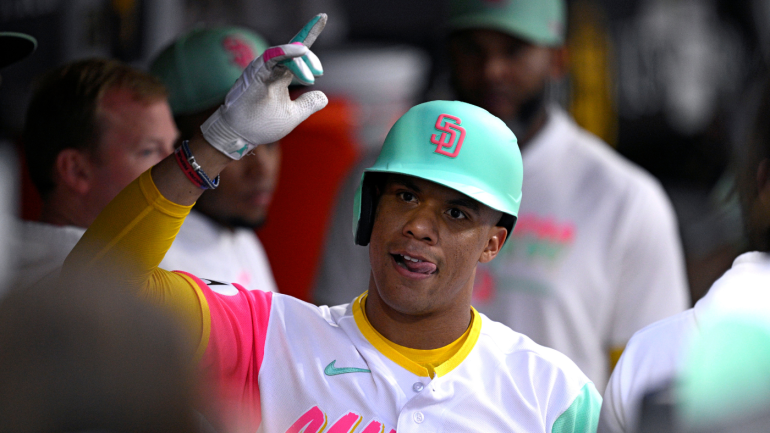
The New York Yankees' blockbuster acquisition of Juan Soto from the San Diego Padres figures to be the biggest trade of the offseason, and it's rich with implications and consequences.
Most essentially, Soto's elite combination of power and on-base skills is precisely what the Yankee lineup needs given their deep struggles of 2023. General manager Brian Cashman badly needed a worthy complement to Aaron Judge, and now he has one. Actually, let's qualify that: he has one for 2024.
The leading subplot to the Soto swap, and the one that made the required return package acceptable to the Yankees, is that the 2024 season will be his walk year – i.e., he's slated for free agency next offseason. That means his stay in the Bronx, while likely to be quite impactful, could be brief. Indeed, there's a handful of reasons to believe that Soto will indeed make it to market and not sign any pre-free agency extension with the Yankees. Let's explore three of those right now.
1. The Scott Boras factor
While the uber-agent Boras isn't strictly averse to having his clients sign extensions that buy out free-agent years, doing so this close to "finish line" would indeed be a rarity. Boras and his marquee clients recognize that free agency is typically the best way to maximize earnings if you get there as soon as you have the requisite six years of MLB service time.
In Soto's case, he's likely to cash in big because he combines youth and established excellence. Across six major-league seasons, Soto has authored a slash line of .284/.421/.524 while averaging 133 walks and 33 home runs per 162 games played. He's highly durable, and he just recently turned 25 years of age. That .421 career OBP leads all active players, and his career OPS+ of 157 is third only to Mike Trout and Judge among active players. That's sky-scraping plate production, and it figures to remain as much for years to come. He's going to get paid on the market in a major way, perhaps to the dance-able tune of $400 million or more. That he's going to land a 2024 salary of $30 million or more in his final year of arbitration eligibility is a bit of a tell on this front.
Moreover, Soto has parried efforts from two different organizations – the Nationals and then the Padres – to sign him to a long-term extension. The Yankees of course have vast resources, but all signs point to Soto's exercising his rights on the free-agent market and resisting any further efforts to buy him out of that opportunity.
2. The Judge example
Looking for a model from the recent past when it comes to a premium batsman playing out his final year of team control with the Yankees? Look no further than the aforementioned Judge. His legendary 2022 season, in which he set the American League single-season home run record and won the MVP award, happened to be his walk year, and a consistent point of discussion is whether the Yankees would be able to ink him to an extension before he reached free agency. As you know, they were unable or unwilling to do that, and Judge did indeed reach free agency. For a time, it looked like he would wind up signing with his (sort of) hometown San Francisco Giants, but in the end the Yankees were able to bring him back on a nine-year, $360 million pact.
The past is prelude until it isn't, so maybe all of this isn't much of a roadmap. Still, if the Yankees weren't able to extend a franchise lifer and icon like Judge before free agency, then it follows that they probably won't do so with a "rental" player who's also a Boras client. The perhaps more realistic hope for Yankee partisans is that they repeat the Judge story arc and strike a deal with Soto after he hits the market. Given that they'll have a relationship in place and can outspend any other team in baseball, that's hardly a far-fetched daydream.
3. Soto's perceived value could rise
While Soto is very much a "power to all fields" kind of hitter, there's a specific reality here that's vital to his 2024 outlook. That reality is that his new home of Yankee Stadium is vastly more friendly to left-handed batters such as himself than his former yard of Petco Park is. According to Statcast measurements, Yankee Stadium over the last three seasons has inflated the home run rates of left-handed batters by 23%. Among MLB ballparks, only Great American Ballpark in Cincinnati is more accommodating toward lefty power. Petco, in contrast, has suppressed left-handed home runs by 16% over that same span. That's a huge difference, even for a hitter like Soto who isn't particularly pull-oriented. Of note with all the sample-size caveats fully in force is that Soto in 28 career plate appearances at Yankee Stadium has a slash line of .261/.393/.826 with four home runs in 23 at-bats.
To be sure, MLB teams are smart enough to correct for single-season boosts driven by ballpark effects, but a leap in power outputs while on the Yankees' watch could reinforce Soto's already solid commitment to test the market. He, after all, is in control of the entire process, and something like his first 40-homer season could reinforce that frame of mind (Soto set a career high with 35 homers in 2023).
In the end, two things seem like reasonable assumptions heading into Soto's walk year. One, he's going to become a free agent. Two, the Yankees will be the early favorites to retain him after he reaches the market. That, though, is a matter for another day – one that won't come until we know how much Soto has helped revive the Yankees in the standings.


















